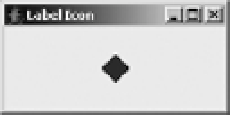Java Reference
In-Depth Information
poly.addPoint(width, halfHeight);
poly.addPoint(halfWidth, height);
}
public int getIconHeight() {
return height;
}
public int getIconWidth() {
return width;
}
public void paintIcon(Component c, Graphics g, int x, int y) {
g.setColor(color);
g.translate(x, y);
if (selected) {
g.fillPolygon(poly);
} else {
g.drawPolygon(poly);
}
g.translate(-x, -y);
}
}
Using an Icon
Once you have your
Icon
implementation, using the
Icon
is as simple as finding a component
with an appropriate property. For example, here's the icon with a
JLabel
:
Icon icon = new DiamondIcon(Color.RED, true, 25, 25);
JLabel label = new JLabel(icon);
Figure 4-10 shows what such a label might look like.
Figure 4-10.
Using an Icon in a JLabel
ImageIcon Class
The
ImageIcon
class presents an implementation of the
Icon
interface for creating glyphs from
AWT
Image
objects, whether from memory (a
byte[ ]
), off a disk (a file name), or over the
network (a
URL
). Unlike with regular
Image
objects, the loading of an
ImageIcon
is immediately
started when the
ImageIcon
is created, though it might not be fully loaded when used. In addition,

